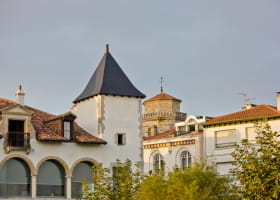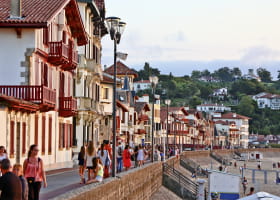
The Socoa district
Zokoako auzogunea
Located in the hollow of the Ciboure - Saint-Jean-de-Luz Bay, Socoa is a district that unusually straddles the towns of Ciboure and Urrugne. Characterized by its Fort’s serrated tower, it has a very strong identity proclaimed by its inhabitants who are proud to be “Zokotars”.
Socoa its port and its fort
Socoa harbour

Socoa had been a small fishing harbour since the Middle Ages, when it housed boats used for whaling.
Silting and modification of the Adour River at the end of the 14th century led to the decline of Bayonne harbour and caused an increase in the activity of Saint-Jean-de-Luz harbour which became cramped. From 1530, Socoa harbour, then belonging to the town of Urrugne, was designed to accommodate around forty ships and construction work of the harbour began in 1617, with tripartite management involving Urrugne, Saint-Jean-de-Luz and Ciboure.
It is composed of three seawalls: the tide gauge seawall, the south seawall and the “little seawall ”, plus a dock that dries up at low tide.
Today, Socoa harbour, in the town of Ciboure, mainly accommodates small boats for fishing or recreation, as well as "battelekus", traditional boats with coloured hulls, which more especially participate in the Teink Trophy.
Socoa Fort
In 1627 Louis XIII ordered the construction of a fort to protect ships moored in the port of Socoa. Socoa Fort is made up of a circular tower, a chapel dedicated to Saint-Peter, and accommodation, all of which are surrounded by protective walls.
It was not until the arrival of Vauban, under Louis XIV, that the Fort was remodelled and took on its military aspect with its serrated tower. Currently the Fort is closed and you can only access the outer parts and the small beach called the Fort Beach.
The large seawall and the protective blocks
Construction of the seawall
Over the centuries, Ciboure and Saint-Jean-de-Luz suffered the incessant assaults of the ocean and was at the mercy of winter storms, going so far as to lose 200m of coastline in 200 years. Only natural promontories protected the bay until their destruction by the onslaught of the ocean.
Many building projects were to follow in order to find a lasting solution to the protection of the towns, and it was at the end of the 19th century, under Napoleon III, that the solution was found with the construction of 3 protective seawalls: Socoa, the Artha and Sainte Barbe.
Since 1898 and the end of this mammoth project, they protect both towns assisted by submerged concrete blocks. When the sea conditions are favourable, a stroll on the Socoa seawall offers one of the most beautiful views of Ciboure and Saint-Jean-de-Luz with the Pyrenees in the background.
Anchoring the blocks
Anchoring the blocks
Since the end of the seawall construction in 1898, a block-anchoring procedure takes place every year. During the summer period, depending on the tides and the wind, around thirty concrete blocks, each weighing 50 tons, are submerged around the 3 seawalls in order to assist them in their protective role as breakwaters. The method used has remained the same since the end of the 19th century, with the use of a particular boat: a block-carrier pontoon. This boat is moored in Socoa harbour.
The blocks are still manufactured in Socoa and stored on site, awaiting immersion. They are visible on the edge of the Untxin River.
Proof of the strength of the waves: during a storm on 28th February 2017, a wave washed up a block on the Artha seawall...
Anchoring the blocks

A lively neighbourhood
Socoa is a very lively neighbourhood with different activities.
Along the promenade that leads to the fort, a succession of colourful hangings displays the different restaurants you can find there that are sure to delight your taste buds. Local gastronomy is well represented in Socoa and is given pride of place during local festivities in La Trinité district, usually in June, which end with a large, animated meal under a marquee.
The promenade, gastronomy, festivities and the beach, but also a whole host of activities related to the ocean are representative of this little corner of the bay. Do you enjoy stand-up paddling, sailing, scuba diving or jet-ski rides? Professionals located not far from the harbour or the fort will be able to answer your needs.
But Socoa is also and above all a district where different economic activities coexist. The shipyards and the local council workshops, where breakwater blocks are manufactured, constitute a significant economic hub. All these activities continue and coexist harmoniously, thus succeeding in combining so-called tourist activities and other activities present on site.
The Socoa fronton
A fronton is located towards the shore. It hosts a pala tournament from June to August, which welcomes the best local players.
For the record, in Socoa the fronton’s framework was apparently built with rails used for transporting material… they are visible when the fronton is due for repainting.
A place for nautical activities
A walk along the Untxin River
In Socoa you can also discover the path along the Untxin River. It goes up and down the river, on the right and left bank following a pretty landscaped path. A wooden footbridge allows you to cross it at the end of the walk.
Before crossing the bridge near the beach, the walk begins on the left leading you to a square with various shops and restaurants with sunny terraces. Every first Sunday of the month a flea market is set up here for the delight of walkers and bargain hunters. The walk leads you to the footbridge that allows you to cross to the “Urrugne side” of the Untxin district. A cycle path connecting Socoa to the town of Urrugne and also the centre of Saint-Jean-de-Luz is a great asset for “two-wheelers”
The path stretches along the river passing by a playground and picnic area where children will enjoy spending time. Every Monday in summer, a market is set up in the large car park on the banks of the Untxin; just follow your nose and the delicious aromas floating in the air will lead you to the market stalls.






















